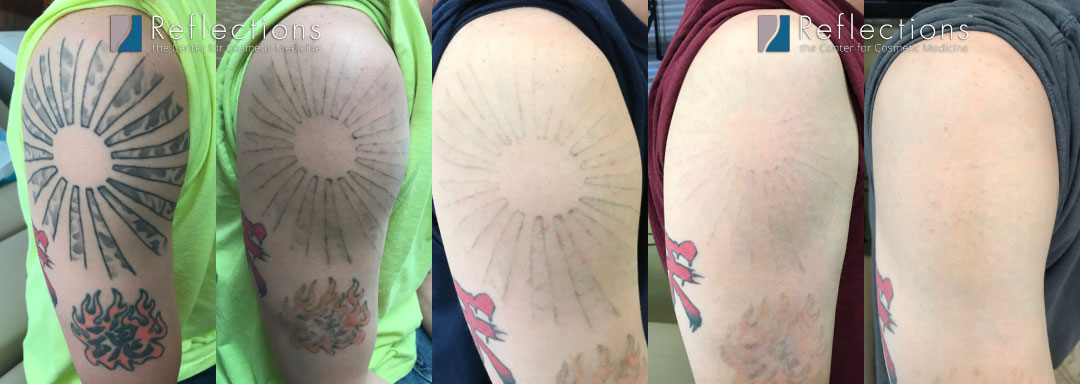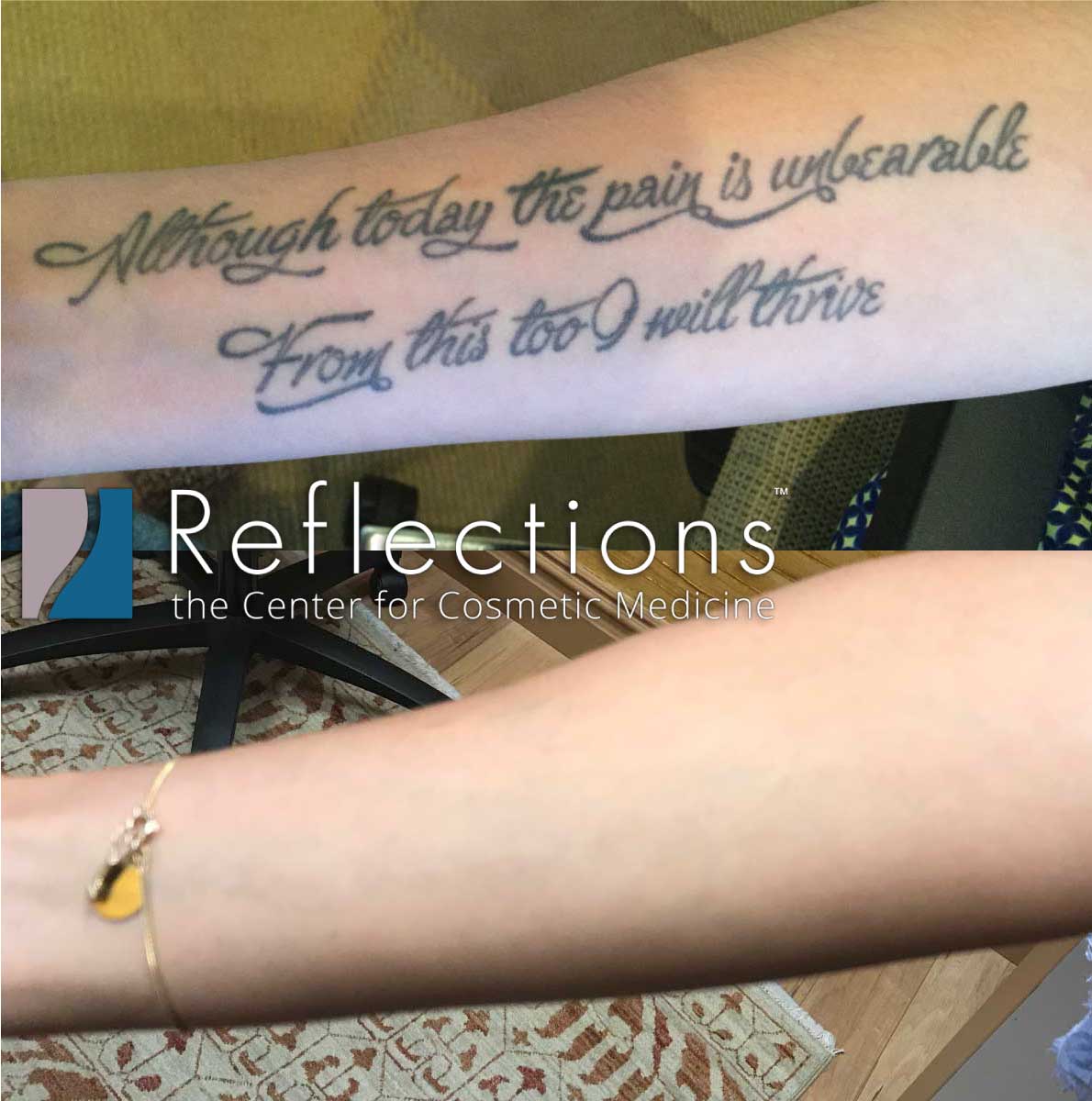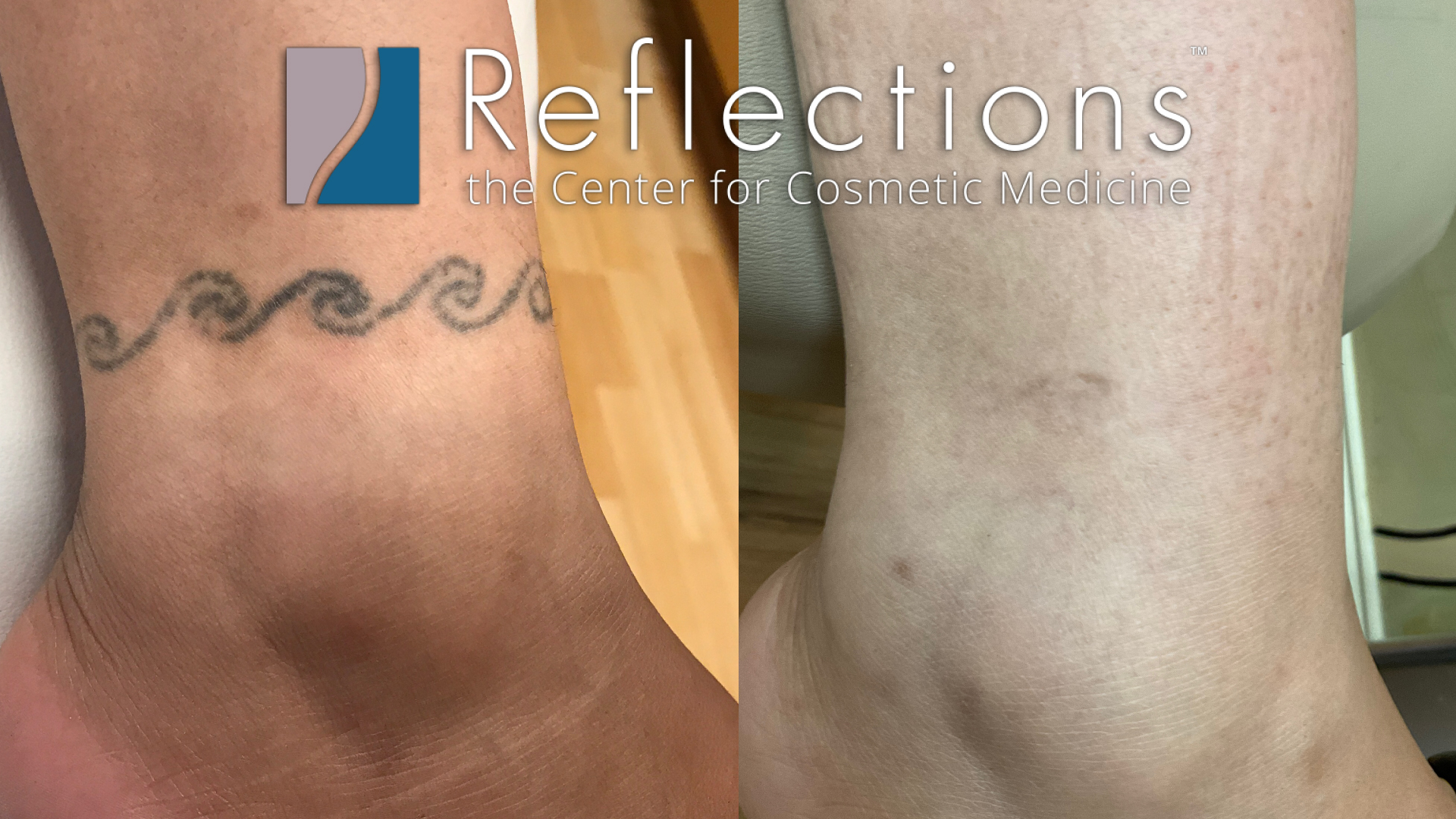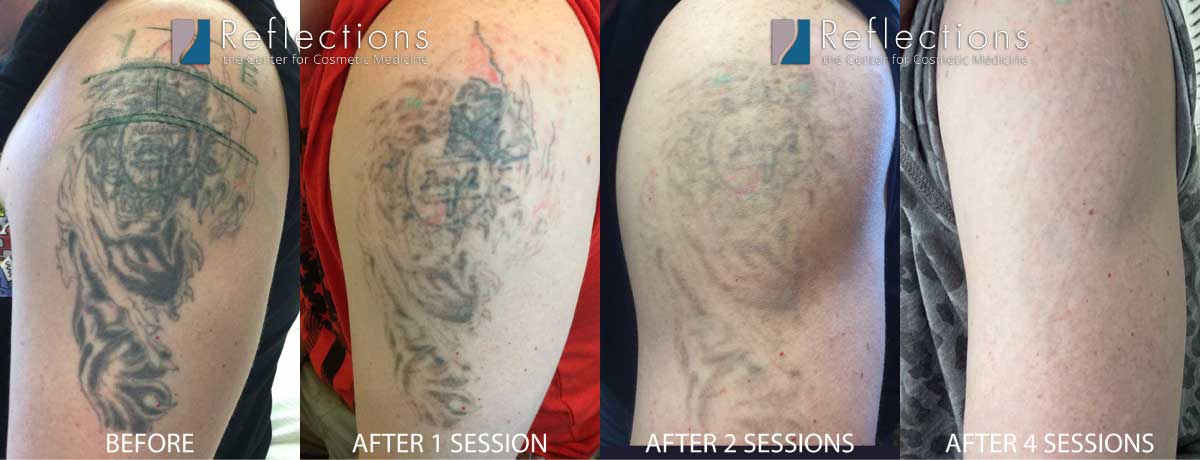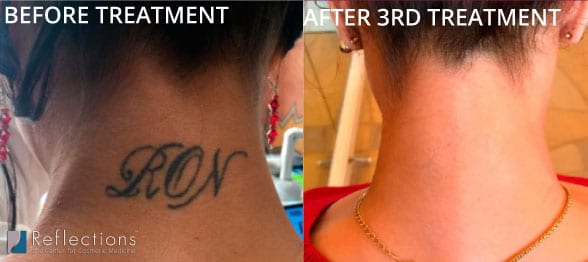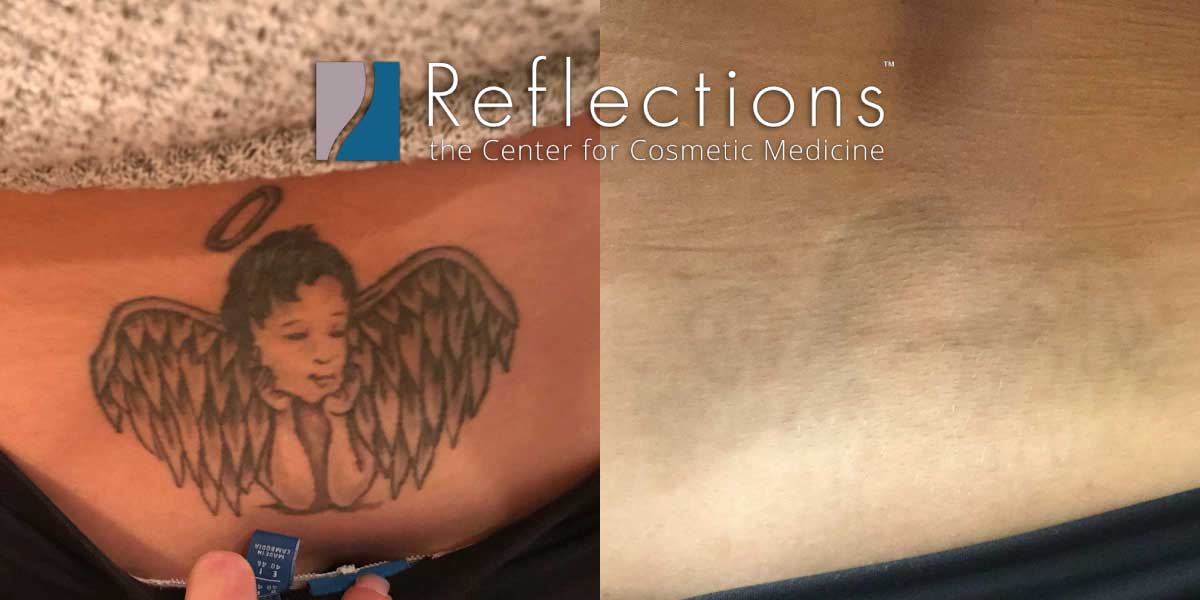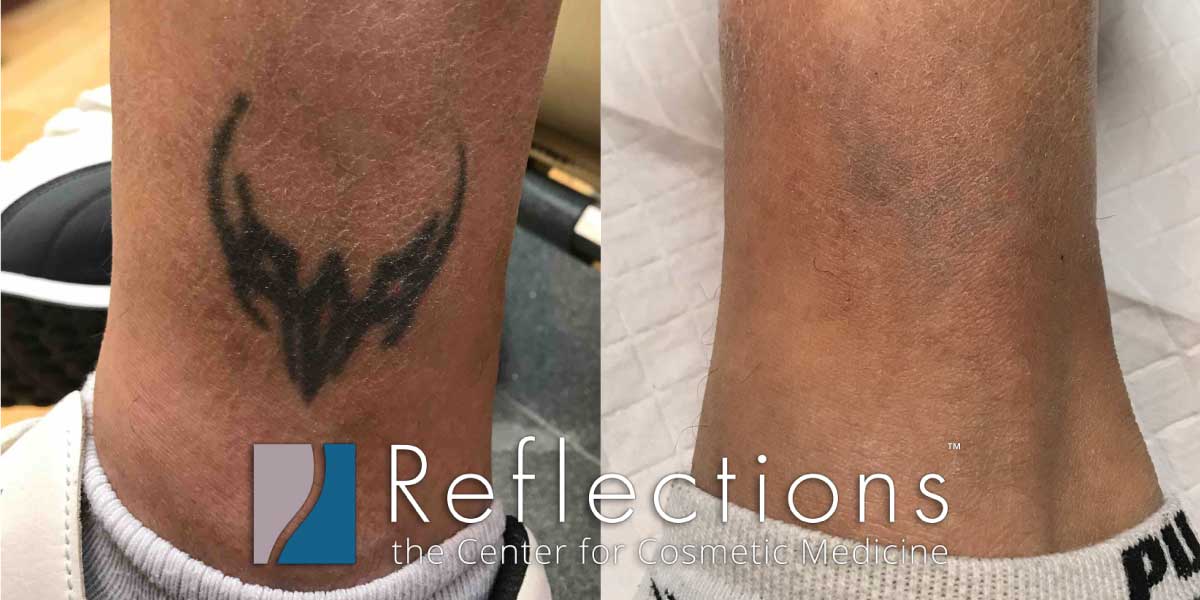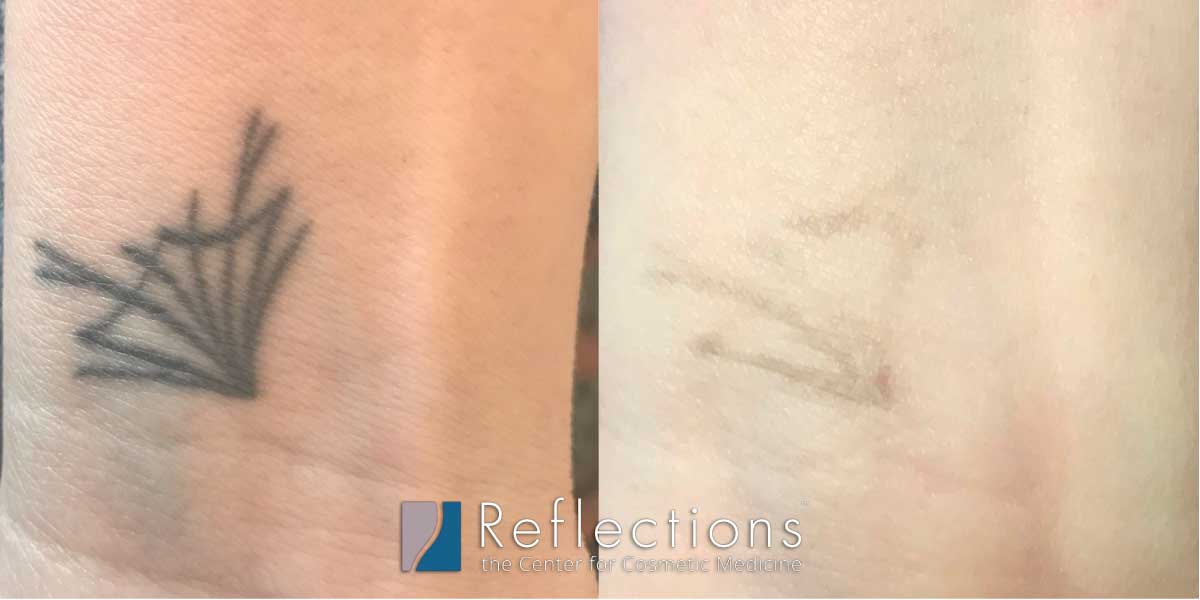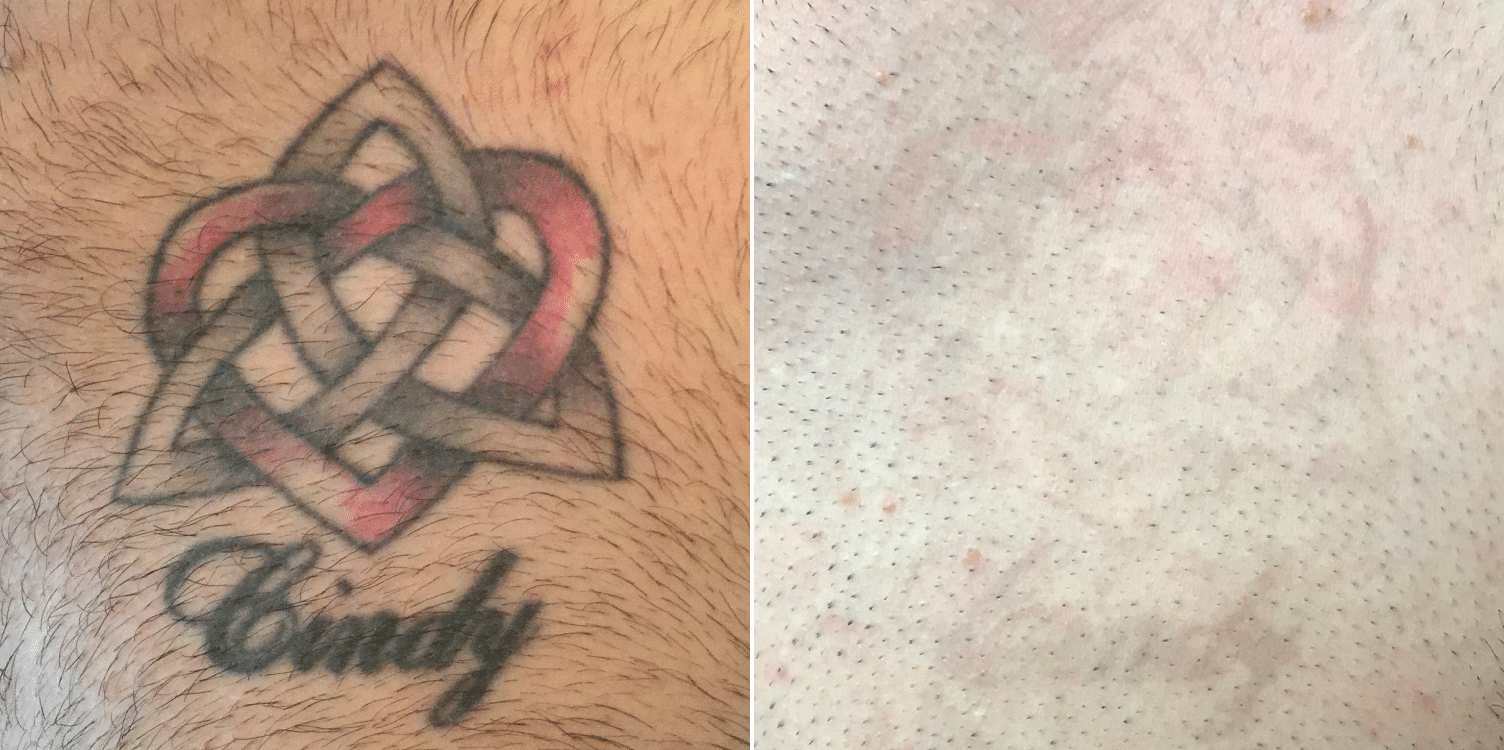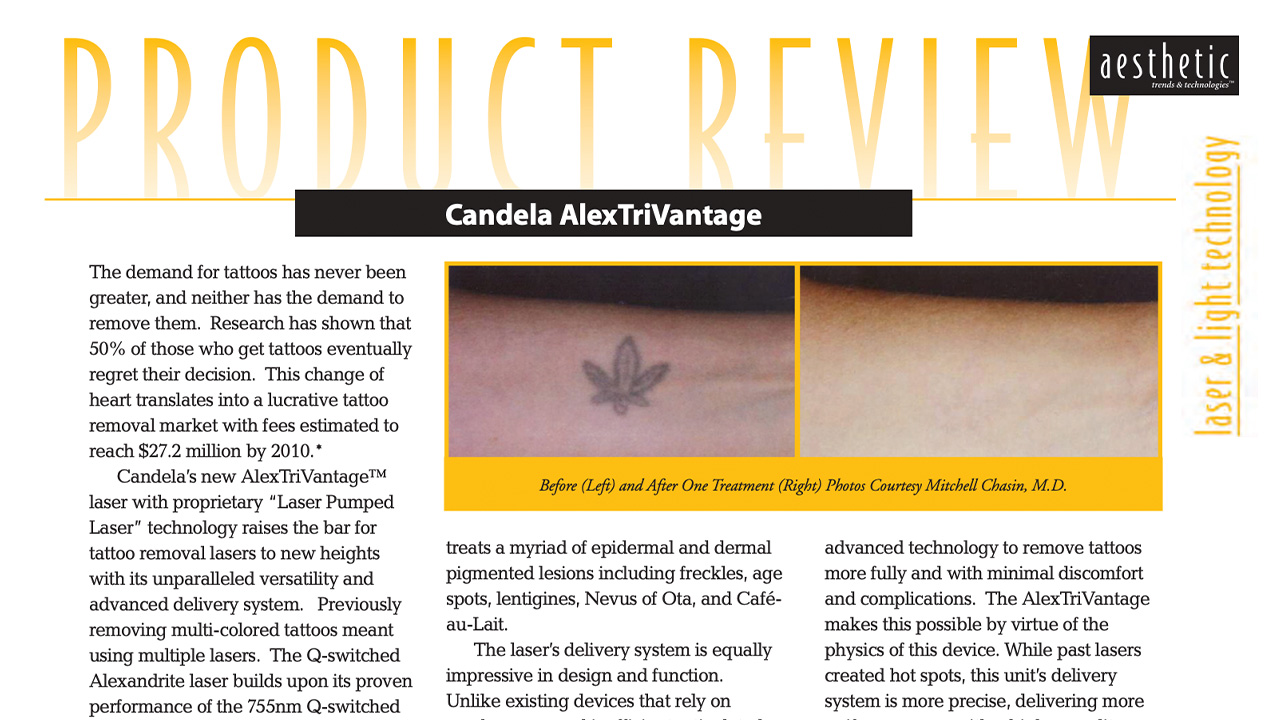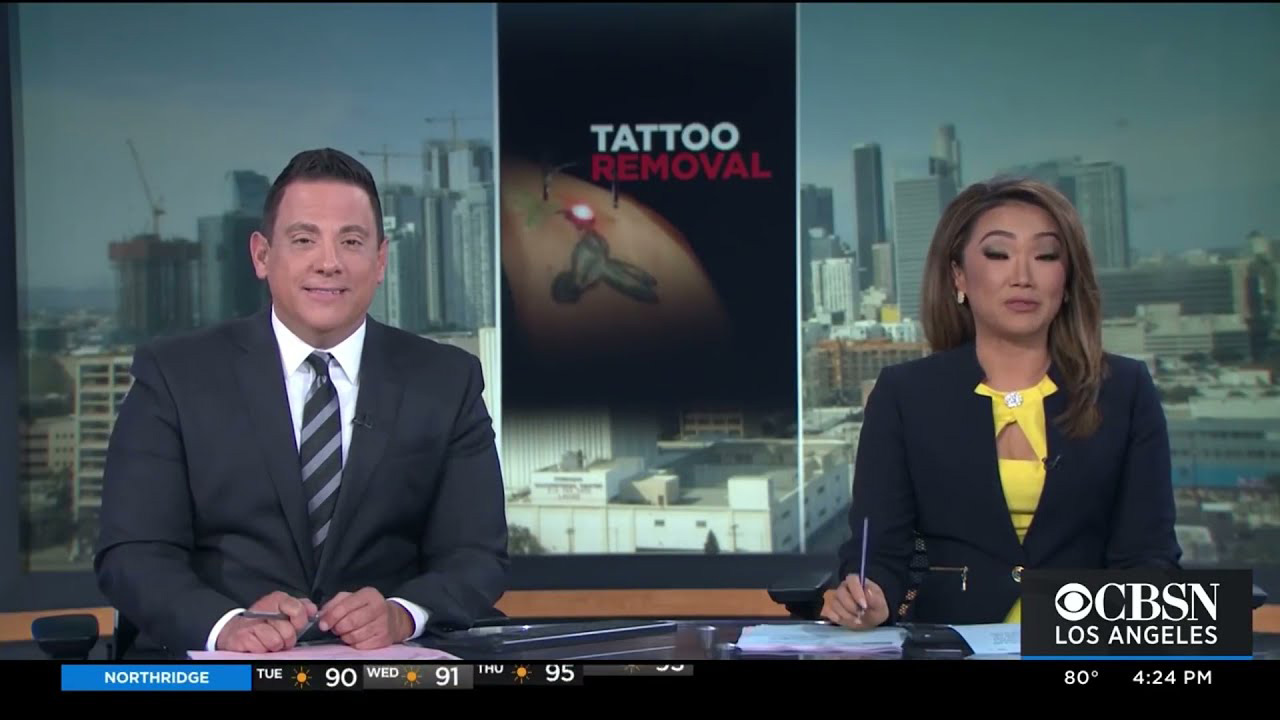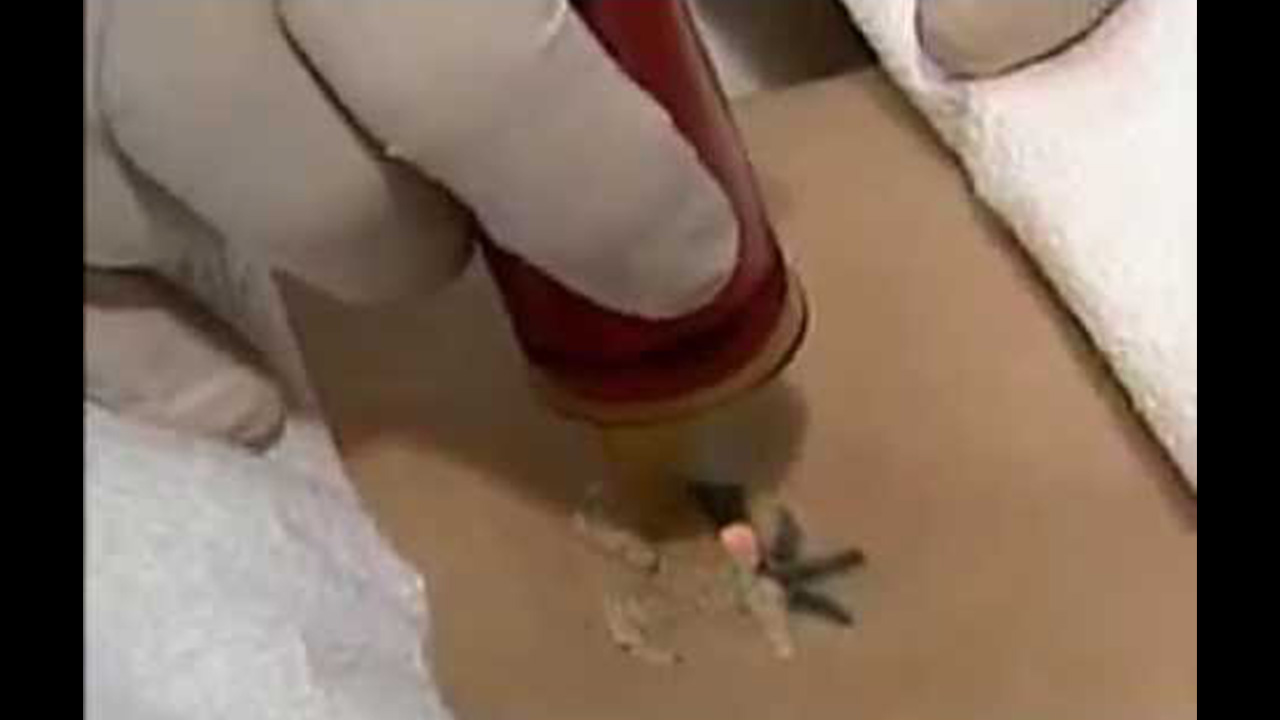We all make mistakes, some more permanent than others. While getting that tattoo might have seemed like a good idea at the time, maybe today it just doesn’t fit with your lifestyle. Wouldn’t it be great if you could turn your tattoo into a distant memory? What if you could restore your tattooed skin to its natural state with the most advanced lasers available for tattoo removal?
In the past, unwanted tattoos were permanent, and removing them could only be attempted through painful, often scar-inducing surgical procedures. But it’s a new day in tattoo removal. You’ll love watching your unwanted tattoo fade away, and your skin restored to its natural state with laser tattoo removal.
RapidTat (R20) Protocol For Fewer Tattoo Removal Sessions
Some of our patients choose our RapidTat protocol, a tattoo removal procedure that lets you condense four laser tattoo removal sessions into one office visit and eliminate unwanted tattoos.
Laser Tattoo Removal Quick Facts
- $200 to $650+ per session, depending upon complexity and size.
- All treatments are performed by doctors who specialize in lasers.
- We treat the most complex tattoos and simple ones.
- The best lasers for fewer treatments and faster results.
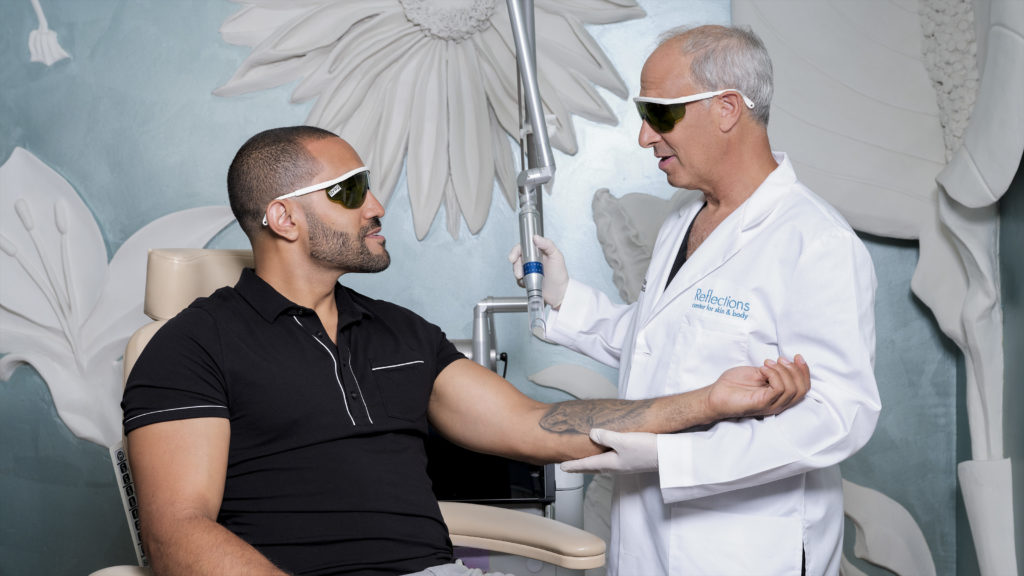
Today’s Best Options for Laser Tattoo Removal in New Jersey
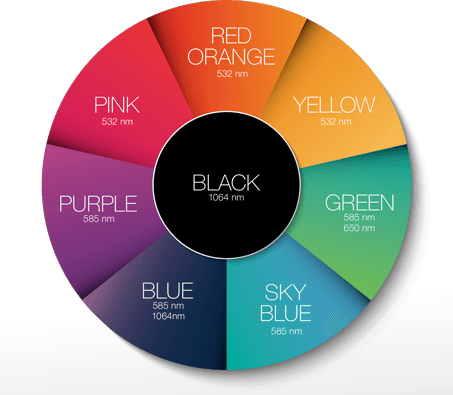
The choice of lasers for treating your tattoo is made by our doctors depending on your skin type and the colors of your tattoo, as well as the tattoo ink, and whether any scar tissue exists around that tattoo.
Different wavelengths of laser are used so that different colors in the tattoo can be targeted during the same session. Black is included in nearly all tattoos, so we invested in the most expensive and powerful laser, the PiQo4, because it clears black tattoo ink so quickly, and is safe for all skin types.
The best laser physicians will use a combination of laser treatments to help you achieve optimal results, and invest wisely to be able to have the right tools (a selection of top-of-the-line lasers that each cost hundreds of thousands of dollars) to do the work safely and effectively.
Common Laser Treatments for Tattoo Removal
We’ve performed thousands of tattoo removals, and know which lasers will work best with your tattoo and skin type. Here are some of the common laser treatments for tattoo removal:
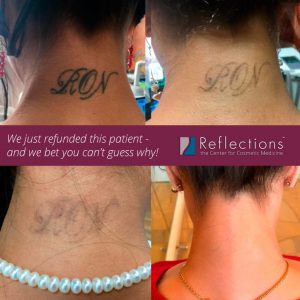
PiQo4
PiQo4 is the most advanced pico-second laser for tattoo removal. Offering 4 wavelengths and a wide variety of intensity and size settings for those wavelengths, the PiQo4 laser offers treatment for a wide variety of tattoo ink types and colors with safe care of darker skin tones that were previously harder to treat with pico-second technologies. PiQo4 is the most powerful pico-second laser on the market, with almost four times the power of its competitors, picoway and picosure.
This patient’s neck tattoo was gone in just 4 sessions, so we refunded her the remaining sessions in the package she had purchased.
Learn More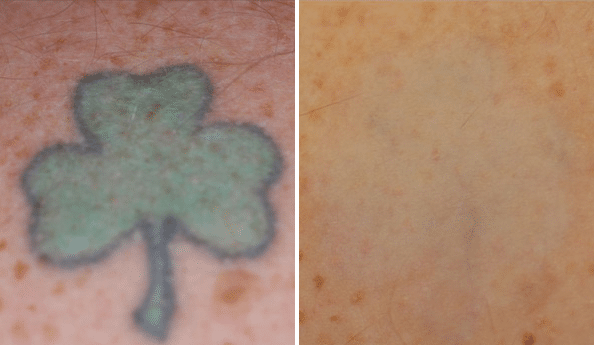
Alex TriVantage®
Alex TriVantage® has pumped-laser technology renowned for it’s superior ability to treat tattoos that include greens, blues, and black. Alex TriVantage is a proven way to treat multicolor tattoos across a broad range of patient skin types.
Learn More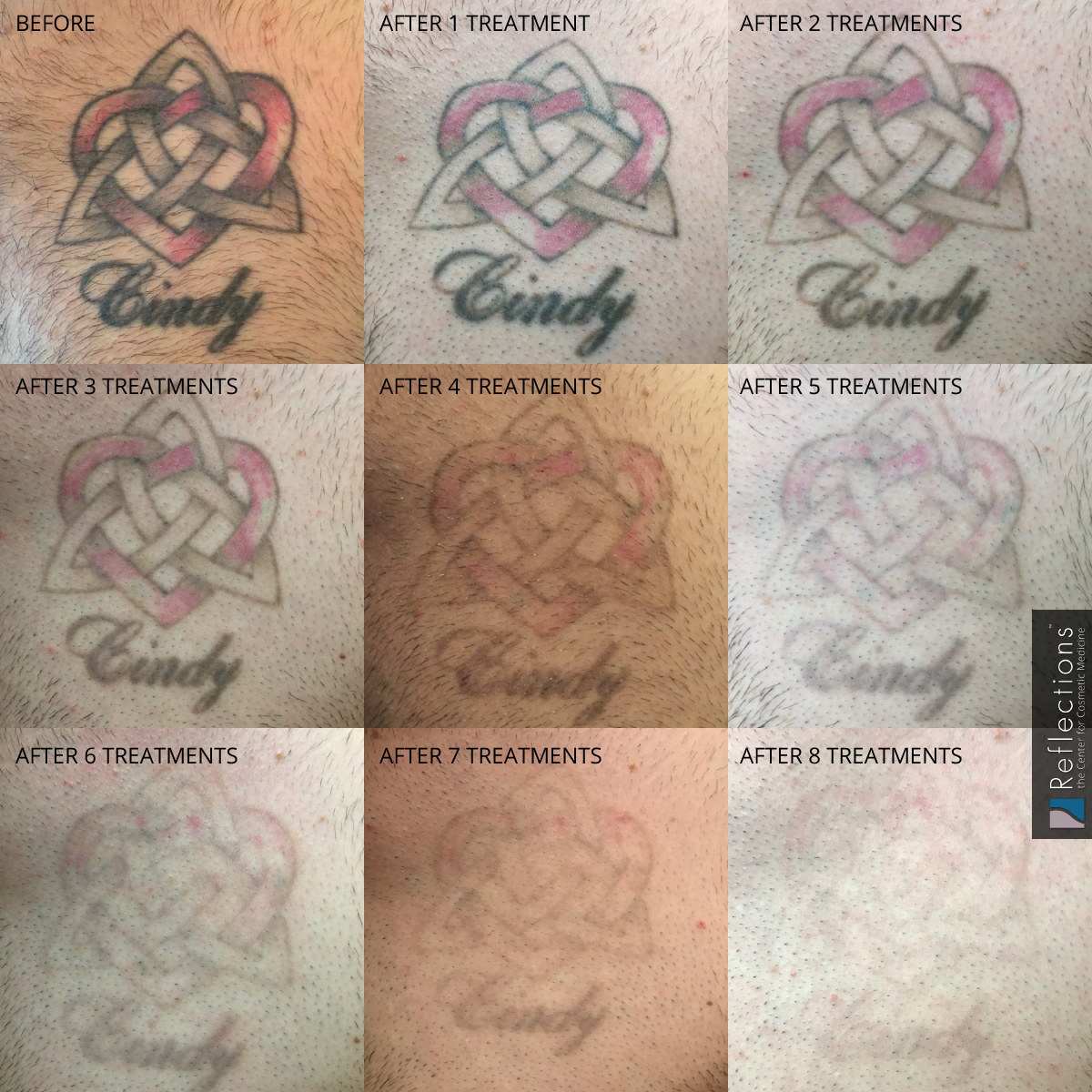
RevLite Q-Switched Nd:YAG
RevLite Q-Switched Nd:YAG laser is a powerful multiple wavelength system used to treat stubborn multi-color tattoos. RevLite delivers energy through the epidermis faster than the skin can react, allowing it to administer a precisely controlled amount of energy into the tattoo ink while minimizing injury to the treatment area. This system is used for patients with both light and dark skin.

Medlite C6
Medlite C6 is an industry-standard laser for multi-colored tattoo removal, with four unique wavelengths. Medlite C6 offers our patients a great, consistent results with no downtime required. It can be used for all skin types and is the safer choice for people with darker complexions.
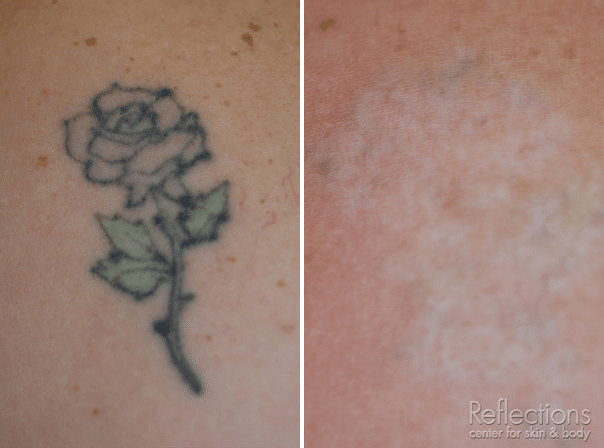
Sinon Ruby
Sinon Ruby Q-Switched laser is ideal for removing black, blue, and green tattoo ink. Ruby is a great option for patients with lighter skin and is frequently used for faded tattoos and those that resist treatment with other devices.
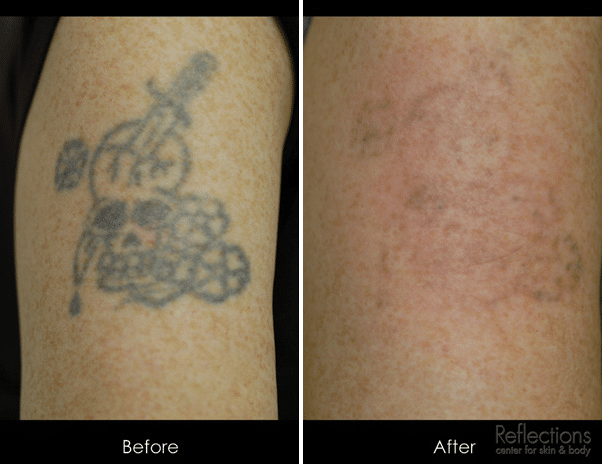
Fraxel Lasers
The Fraxel Re:Store Dual laser or the Fraxel CO2 Re:Pair can be used during tattoo removal to help remove any scar tissue the treatment area, allowing our doctors to use more aggressive laser settings for a faster result. It has also been thought that the Fraxel laser energy helps to breakdown the ink pigment under the skin, regardless of the color of that ink, aiding in the removal process.
Learn More| Treatment | Cost | Works Best For | Appropriate for Fitzpatrick Skin Types |
|---|---|---|---|
| PiQo4 Picosecond Laser | "$250 - $650+ Per Treatment, Multiple Sessions Recommended Reduced Package Pricing Available" | Best for Black, Blue and Red ink | 1-6 |
| Alex TriVantage Laser | "$250 - $650+ Per Treatment, Multiple Sessions Recommended Reduced Package Pricing Available" | Best for Green and Blue ink | 1-4 |
Ruby Laser |
"$250 - $650+ Per Treatment, Multiple Sessions Recommended Reduced Package Pricing Available" | best for Resistant black. blue. green ink | 1-4 |
Revlite Laser |
"$250 - $650+ Per Treatment, Multiple Sessions Recommended Reduced Package Pricing Available" | Best for Black, Blue and Red ink | 1-6 |
Medlite C6 Laser |
"$250 - $650+ Per Treatment, Multiple Sessions Recommended Reduced Package Pricing Available" | Best for Black, Blue and Red ink | 1-6 |
| Fraxel Dual Re:Store Laser | "$250 - $650+ Per Treatment, Multiple Sessions Recommended Reduced Package Pricing Available" | Used for resistant ink, especially in setting of scar tissue present in area of tattoo | 1-6 |
| Fraxel Re:Pair Co2 Laser | "$300 - $750+ Per Treatment, Multiple Sessions Recommended Reduced Package Pricing Available" | Used for resistant ink, especially in setting of scar tissue present in area of tattoo | 1-3 |

View More Laser Tattoo Removal
Before & After Images
More Before & Afters
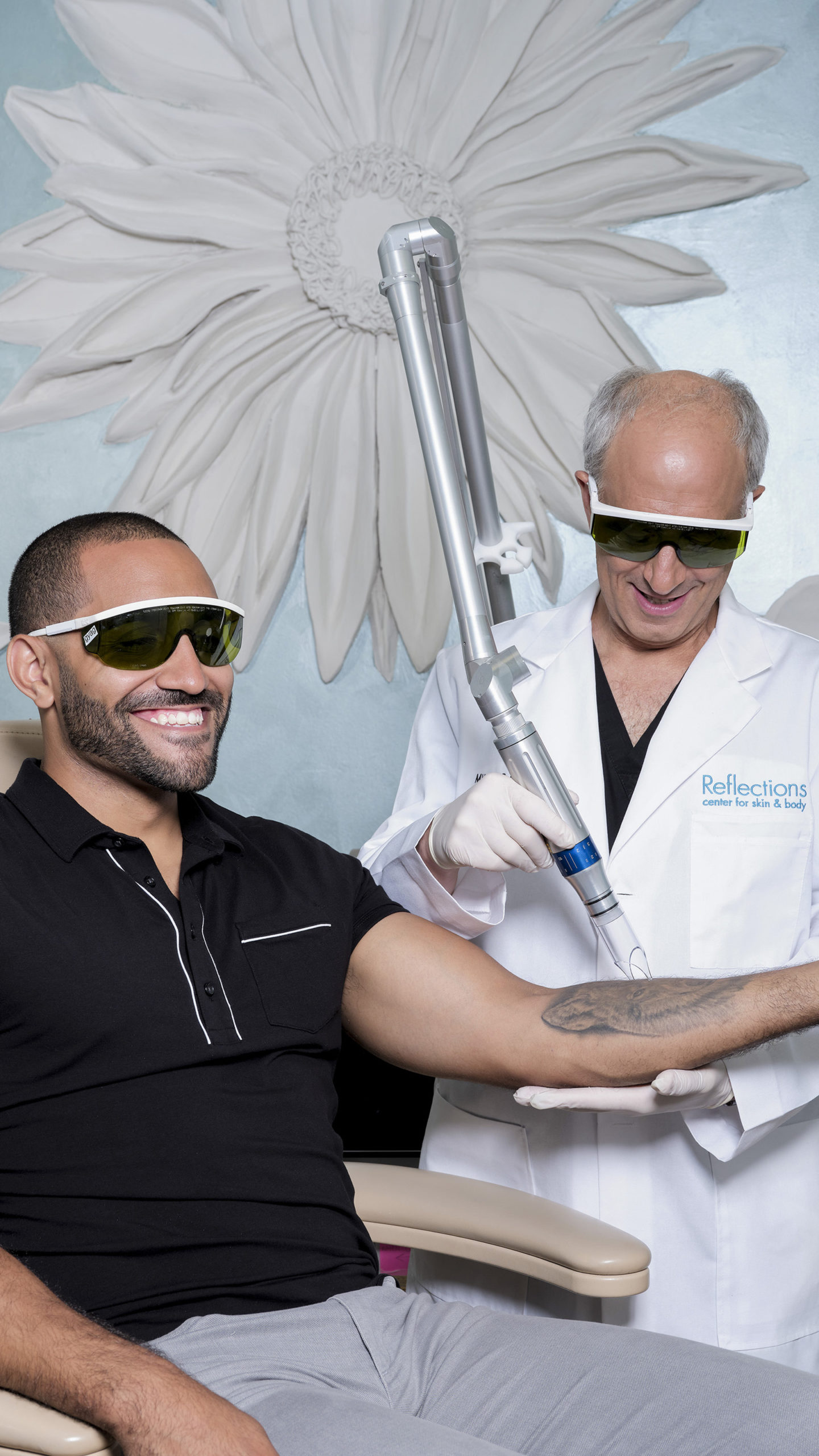

Why Choose Reflections For Laser Tattoo Removal
Safe and effective tattoo removal comes down to a skilled physician choosing the right laser wavelengths for your skin type and the color of your tattoo5. At Reflections, our expert physicians use every laser wavelength on the market today and are adept at choosing the ideal combination of lasers to provide the best possible results.
Unlike some other facilities limited by a single device, we have invested heavily in laser tattoo removal technology and will expertly tailor a treatment approach that uses the ideal wavelength for your tattoo color(s), your skin type and your treatment goals. We use only the most advanced, FDA-approved lasers available today for tattoo removal.
Experience the Reflections difference — a team dedicated to perfecting the craft of using lasers to obtain the best results for our patients. It’s why plastic surgery and dermatology offices send their patients to us, and why tattoo parlors refer their clients our way when they are looking to wipe the slate clean and rethink their ink.
Ready to start fading your unwanted ink today? Call us for a FREE consultation at (973) 740-2444.
Our Doctors on TV & In Magazines, Talking
About Laser Tattoo Removal
View All Media
Alternative Tattoo Removal Methods
Unfortunately, there are not a lot of great alternatives to laser treatment to remove tattoos. There are creams available on the market, there are abrasives, there are devices to scrape, and there are chemicals that burn the skin. These are not effective, and the scarring and loss of pigment from trying to remove a tattoo by yourself at home can make it much more difficult and sometimes even impossible to produce great results with a laser. Surgical removal is almost never recommended because of the significant chance of visible scarring. Rather than trying other tattoo removal methods, we strongly recommend consulting a cosmetic physician to discuss options.
Learn more about Permanent Makeup Tattoo Removal, a distinct style of tattoo removal we provide.

Blog
Infographic: Laser Tattoo Removal Motives and Methods
Reflections, offers laser tattoo removal treatment at very affordable cost. We...
Read More
Blog
Laser tattoo removal helps celebrities move on
Reflections for laser tattoo removal. Twilight actress Nikki Reed recently got...
Read More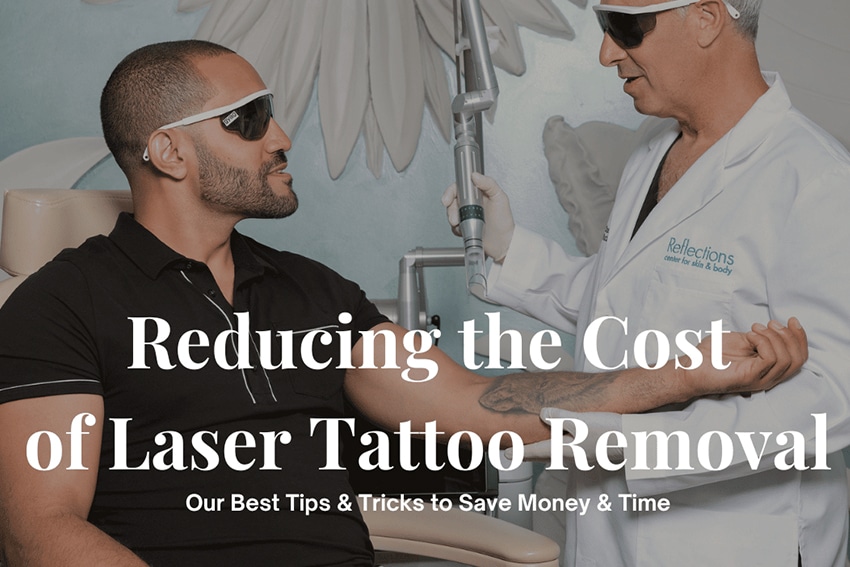
Blog
Reducing the Cost of Tattoo Removal: How to Maximize Your Laser Tattoo Removal Treatments’ Results
The number 1 reason people put off tattoo removal is the cost In general, the...
Read MoreFrequently Asked Questions About Laser Tattoo Removal
- How does laser tattoo removal work?
The most common lasers developed specifically for use in tattoo removal use a technique known as Q-Switching. Q-Switched lasers produce short pulses (billionth of a second) of intense light that pass through the top layers of the skin and are selectively absorbed by the tattoo pigment. This laser energy causes the tattoo pigment to fragment into smaller particles that are then absorbed by the body’s immune system2.
The laser we use depends on the colors in your tattoo and your skin type, as different laser wavelengths are better absorbed by different colors of ink and are safer for certain skin types. For green tattoos that prove resistant to Q-Switched lasers, there’s a new class of tattoo removal lasers called “picosecond” devices (such as the Cynosure PicoSure) that can be used these types of stubborn ink.
Treatment typically includes four or more sessions, spaced apart by six to eight weeks. Your number of treatments will depend on the type and color of ink used in your tattoo, how much of it was used to create your tattoo, and how deeply it was injected into your skin.
- How many sessions will I need?
Several laser tattoo removal treatments are normally needed to reach an endpoint — the number of sessions depends on the amount and type of ink used and how deeply it was injected, but can vary anywhere from four to ten, or even more. Six to eight-week intervals between sessions are required to allow pigment residue to be absorbed by the body.
We don’t generally know which of the over 500 tattoo inks available today were used to create the tattoo and sometimes the pigments undergo chemical changes after the tattoo is placed. Even two identically colored tattoos may be derived from very different colors and types of inks.
The easiest tattoos to remove are ones with containing black ink. In contrast, the hardest are the multi-colored tattoos, especially containing floral and pastel colors5.
- What do I do to prepare for laser tattoo removal?
Avoid tanning the skin before laser tattoo removal. Also, avoid applying makeup or cover up to the area before treatment. We recommend avoiding the use of aspirin before laser tattoo removal, instead choosing non-aspirin products, like Tylenol or ibuprofen for minor aches and pains prior to the procedure. Notify your physician if you are prone to keloid scarring to determine if you’re still a candidate for laser tattoo removal.
- Does laser tattoo removal hurt?
Advanced tattoo removal lasers are much faster and less traumatic to the skin than previous technologies, making the treatment much more comfortable3. The impact of the energy from the laser’s powerful pulse of light has been described as similar to getting snapped by a thin hot, rubber band. With each subsequent treatment, the discomfort fades.
Methods for anesthesia vary from a Zimmer air chiller, topical, or injectable anesthesia.
- What will I look and feel like after the treatment?
The treatment will leave the skin mildly red and may result in pinpoint bleeding or blistering. One may notice a temporary whitening of the tattoo and swelling of the skin in the region. Over the next few weeks, the body’s scavenger cells remove pigment residues. One begins to notice lightening of the tattoo approximately two weeks post treatment and this will continue for two to three months.
Following treatment, the doctor will apply an antibacterial ointment and dressing to the area. The skin should be kept clean with continued application of ointment as directed. A shower or bath the day after treatment is okay, but the treatment area should not be scrubbed. Your skin might feel slightly sunburned for a couple of days and the treated area may remain red for a few weeks. If the skin forms a blister or scab, this should be handled gently. After healing, the tattoo color will gradually and continually fade1.
- I have a full sleeve but only want to remove part of it. Is that possible?
With tattoo removal, we can remove any part of a tattoo or the whole tattoo. One common scenario where we remove only part of the tattoo is employment with the military or police force. Very commonly, these two institutions don’t want a tattoo showing that extends beyond the sleeve or beyond the collar. Another scenario is when you just doesn’t like part of the tattoo, and we can remove that so you can go back and touch up the tattoo later.
- How can I make sure that I get good results?
The key with tattoo removal is using the right wavelength of light— meaning the right laser for the color of the tattoo ink and the color of the skin. Unfortunately, there’s not a one-size-fits-all device that treats all the colors of tattoos that we commonly see. In this case, we may use what we call a YAG laser that treats a black tattoo, an Alexandrite laser that treats a green, and a Ruby laser that treats blue. So, when selecting a cosmetic physician to treat your tattoos, make sure they have multiple devices so they can tailor the treatment specifically to the color of the tattoo. Secondly, someone with darker skin is going to require a different technology than someone with lighter skin.
- Can you guarantee that all the ink will be removed?
No, the extent of the ink that can be removed depends on many factors, including the physical nature of ink used, its color, how much was injected into your skin, and how deeply it was placed.
- Can multiple lasers be used in the same visit?
Yes, it’s the most efficient way to clear a tattoo, but a multiple-wavelength session is best left to experienced physicians2,4.
- Can I have a new tattoo placed over where the old one was?
Yes — some of the most flattering referrals we get are from tattoo artists who send their clients to Reflections when they wish to revise their artwork. They choose us because we send their clients back with their skin in great condition.
- What are the possible side effects?
Side effects of laser procedures are generally few but may include hyperpigmentation, or the darkening of the skin at the treatment site, and hypopigmentation, where the treated area lacks normal skin color. Other possible side effects include infection of the site, textural changes in the skin and permanent scarring. Treatment of tanned skin increases the complication rate and should be avoided. The use of advanced lasers designed specifically for your skin type and the color of your tattoo and the experience of your physician factor into the risk of complications5.
- How is ink processed out of the body?
During treatment, the laser “explodes” the ink under the skin and then through a variety of mechanisms, the body clears that ink through its immune system. Some of the ink actually goes right through the air and is excreted. So, over a period of time, the tattoo will get lighter and lighter.
- If I get a tattoo, what should I know?
Go to a reputable practitioner who is using advanced and sterile instruments and choose a facility that is clean and up to date. Try to choose as few colors as possible and gravitate towards dark green, black and blue. Avoid pastel colors, yellow, orange, and white, as they are harder to remove5. Consider having the tattoo placed in an area that is easily coverable with clothing in case you regret the decision later.
- How does one choose a provider for laser tattoo removal?
There are several factors that will help ensure that you choose the right physician and facility for laser tattoo removal. First, make sure that the practitioner is indeed a physician. Next, ask the practitioner if he owns or rents the technology he will be utilizing. A physician who rents or uses a hospital-based system normally doesn’t perform enough treatments to warrant purchasing the lasers, leaving the possibility that they are inexperienced. Rental lasers may also be improperly calibrated and result in bad outcomes. Make sure the technologies are indeed lasers (sometimes the term is used loosely) and are new.
Choose a physician who owns several tattoo lasers and has the full complement of wavelengths to treat all tattoo colors. If this is not the case, it may compromise care and result in inadequate removal of the tattoo pigment or even scarring5.
Lastly, choose a physician who focuses their entire practice on laser and aesthetic medicine, and not one who has a different area of interest and uses lasers part time. Look around the office carefully. Make sure it is clean and up to date. Look for other lasers used for hair removal, skin rejuvenation, acne, rosacea, skin resurfacing and acne scars, etc. This demonstrates experience and dedication to the field, which can make a big difference in the quality of care you receive. - How much is tattoo removal?
We price tattoo removal by the size of the area being treated, with a single session ranging from $200 to $650 (and upwards).
Almost all tattoos require multiple treatments, so the cost of a tattoo may vary.
Some factors that affect the rate of tattoo removal include:
-Tattoo layering
-Location of your tattoo
-Your skin type
-The color and amount of ink
-Any pre-existing scars
One of the most effective ways to reduce the cost of your tattoo removal is to decrease the number of sessions you need – and that means seeing a physician who has the best lasers and knows how to make each session as effective as possible. We cover that, as well as what you can individually do before and after your treatments to make them more effective, in this blog. Most laser treatments will take multiple sessions for the complete removal of your tattoo. Even though it depends on your body’s ability to remove ink, most specialists recommend multiple sessions at a gap of 6-8 weeks.
- How many treatments do I need for tattoo removal?
Laser tattoo removal is different for each patient since every person and their tattoo is unique. This means that it is not possible to predict the exact number of treatments that will be required to achieve complete removal of a tattoo. Most professional tattoos take around 6 to 12 treatment sessions for complete removal.
A tattoo removal center will take into consideration several factors before the number of treatments can be decided. Some of these factors include your skin type, tone, layering of the tattoo, location, pigmentation, the amount of ink applied to your tattoo, the kind of pigment used, whether homemade pigment or professional ink was used, and any pre-existing scars from the tattoo. Other than these factors regarding the tattoo itself, your cosmetic physician will also want to know if your immune system is healthy and whether you are a smoker.
Once all these and more factors are taken into consideration, your tattoo removal center will be able to decide on the number of treatments that will be required to completely remove your tattoo.
The PicoWay laser procedure is able to remove professional tattoos within 4 to 6 treatments, whereas amateur tattoos take about 2 to 3 treatments. The success of your tattoo removal also depends on the ability of your body to break down the ink, which depends on your general health. When you consult experienced specialists who use the most advanced technology and effective laser treatments, they will be able to remove your tattoos in fewer treatment sessions.
- What should I do after laser treatment for my tattoo?
Like with any kind of any wound, you will want to treat the skin very gently. You don’t want to expose it to sun since that can create pigmentary issues. You’ll want to keep it moist using different things like Aquaphor or Bacitracin and keep it covered to prevent it from getting dirty. Resist the urge to scratch it and peel it. Avoid popping or poking at any blisters that might form.
- How effective is laser tattoo removal?
If you regret a tattoo and want to look at your options, laser tattoo removal is the most effective treatment for eliminating it. Laser tattoo removal is safe for all kinds of skin tones and works on many types of inks. Usually it takes about 3 to 10 treatment sessions for removal, and these sessions are spaced at 4 to 6 weeks. Different kinds of laser treatments are used for removing different kinds of tattoos. For instance, the alexandrite laser is most effective in removing the green-colored tattoo pigment, even though it removes blue and black pigments as well.
There are a few factors that need to be considered before deciding the effectiveness of the laser removal technique in your specific case. The cosmetic physician at your tattoo removal consultation will check factors like the nature of the ink that was used for your tattoo, the amount of the ink used, and how deep was the ink injected. Some other factors that are taken into account are the age of your tattoo, the location of the tattoo on your body, and whether you have had previous treatments. Tattoo removal is a process that requires patience, since it could take a year or more to fully remove certain tattoos; for instance, green color in a tattoo is the most difficult to remove.
The reason why tattoo removal takes so long is because it is a cyclical procedure. Once the laser breaks up the ink molecules in your tattoo, the lymphatic system takes 4 to 6 weeks to absorb these molecules and clear them from your body. This is why the placement of your tattoo plays an important role in the amount of time it takes for its removal; the closer it is to your heart, the more quickly it can be eliminated. Even when your laser removal treatment cannot promise you complete removal of the tattoo after considering all the factors, it will often fade enough so that you can get a cover-up tattoo.
- I'm black and I've heard lasers can be bad for black skin. Can I have a black tattoo removed? Will it leave white spots behind?
We can treat tattoos in patients that have darker skin— the key is what wavelength or laser has been utilized. The specific wavelength of light is usually 1064 to remove a black tattoo in someone who has darker skin. So, lasers like Picosure may cause complications like white spots since it doesn’t produce the correct wavelength.
- How long does it take for a tattoo to fade?
The effectiveness and length of a laser tattoo removal treatment package depend on many factors. Each tattoo is different and comes with different pigments, techniques, quality, and reactivity. However, each tattoo will require multiple sessions to produce results. Some treatment packages can require as few as four treatments or as many as ten—or more. As a general rule, black inks are easiest to fade, while bright and pastel colors will be more difficult.
Sources:
- Richard E. Fitzpatrick, MD; Mitchel P. Goldman, MD; Tattoo Removal Using the Alexandrite Laser; Arch Dermatol. 1994;130(12):1508-1514. doi:10.1001/archderm.1994.01690120044006.
- Bernstein, E. F. and Civiok, J. M. (2013), A continuously variable beam-diameter, high-fluence, Q-switched Nd:YAG laser for tattoo removal: Comparison of the maximum beam diameter to a standard 4-mm-diameter treatment beam. Lasers Surg. Med., 45: 621–627. doi: 10.1002/lsm.22203
- Tina S Alster, MD; Q-switched alexandrite laser treatment (755 nm) of professional and amateur tattoos; Journal of the American Academy of Dermatology; Volume 33, Issue 1, July 1995, Pages 69–73
- E. Victor Ross, USN; George Naseef, MD; Charles Lin, PhD; Michael Kelly, MS; Norm Michaud, MS; Thomas J. Flotte, MD; Jill Raythen; R. Rox Anderson, MD; Comparison of Responses of Tattoos to Picosecond and Nanosecond Q-Switched Neodymium:YAG Lasers; Arch Dermatol. 1998;134(2):167-171. doi:10.1001/archderm.134.2.167.
- Jeremy B. Green, MD and Andrei I. Metelitsa, MD, FRCPC; Optimizing Outcomes of Laser Tattoo Removal ; Skin Therapy Letter, 2011.

Dr. Mitchell Chasin is a Cosmetic & Laser Physician at Reflections Center. Dr. Chasin believes strongly that the best cosmetic physicians are those who are dedicated to mastering their craft through continuing education and collaboration with the industry’s top doctors.







